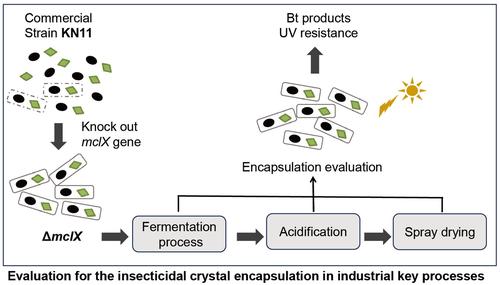当前位置:
X-MOL 学术
›
Pest Manag. Sci.
›
论文详情
Our official English website, www.x-mol.net, welcomes your
feedback! (Note: you will need to create a separate account there.)
Evaluation of the strategy for insecticidal crystal encapsulation with cell wall in industrial processes
Pest Management Science ( IF 3.8 ) Pub Date : 2024-11-15 , DOI: 10.1002/ps.8537 Yujia Hou, Xin Zhang, Li Zhou, Yanrong Xu, Yuanhong Zhu, Tinglu Yan, Qi Peng, Huamei Liu, Fuping Song
Pest Management Science ( IF 3.8 ) Pub Date : 2024-11-15 , DOI: 10.1002/ps.8537 Yujia Hou, Xin Zhang, Li Zhou, Yanrong Xu, Yuanhong Zhu, Tinglu Yan, Qi Peng, Huamei Liu, Fuping Song

|
BACKGROUNDBacillus thuringiensis (Bt) can produce insecticidal crystal proteins during sporulation, and these are the basis of the most successful microbial insecticides in use today. However, the susceptibility of insecticidal crystal proteins to inactivation by ultraviolet (UV) radiation from sunlight causes damage to the insecticidal crystals and subsequent loss of toxicity. The deletion of the mclX gene, an unknown functional gene, can make the insecticidal crystal proteins become encapsulated by the cell wall which provides some protection against UV radiation. This study evaluates the potential of this innovative strategy during the industrial process of commercial strain KN11.RESULTSGene mclX was deleted from a commercial Bt strain KN11 successfully, and the mutant strain was cultured under different conditions, including laboratory and industrial fermentation conditions. The mother cells of the mclX mutant strain remained nonlysed after industrial processes. The deletion of mclX had no adverse effects on the production of Cry1Ac protein and no impact on the insecticidal activity. Most noteworthy, the ΔmclX mutant had improved UV resistance and insecticidal activity compared to the wild‐type KN11 strain.CONCLUSIONThis finding suggests that commercial strains can be genetically modified to encapsulate insecticidal crystal in Bt products using the mclX mutation strategy. This study evaluated the ability of commercial strains lacking the mclX gene to encapsulate crystals giving resistance to UV radiation. © 2024 Society of Chemical Industry.
中文翻译:

工业过程中细胞壁杀虫晶体包埋策略的评价
背景苏云金芽孢杆菌 (Bt) 可以在孢子形成过程中产生杀虫晶体蛋白,这些是当今使用的最成功的微生物杀虫剂的基础。然而,杀虫剂晶体蛋白对来自阳光的紫外线 (UV) 辐射的灭活敏感性会导致杀虫剂晶体受损并随后失去毒性。mclX 基因(一种未知的功能基因)的缺失可以使杀虫晶体蛋白被细胞壁包裹,从而提供一些针对紫外线辐射的保护。本研究评估了这种创新策略在商业菌株 KN11 工业过程中的潜力。结果成功从市售 Bt 菌株 KN11 中删除 Gene mclX,并在不同条件下培养突变菌株,包括实验室和工业发酵条件。mclX 突变菌株的母细胞在工业过程后仍未裂解。mclX 的缺失对 Cry1Ac 蛋白的产生没有不利影响,对杀虫活性也没有影响。最值得注意的是,与野生型 KN11 菌株相比,ΔmclX 突变体具有更高的抗紫外线性和杀虫活性。结论这一发现表明,可以使用 mclX 突变策略对商业菌株进行基因改造,以将杀虫晶体封装在 Bt 产品中。本研究评估了缺乏 mclX 基因的商业菌株包封晶体的能力,从而抵抗紫外线辐射。© 2024 化工学会.
更新日期:2024-11-15
中文翻译:

工业过程中细胞壁杀虫晶体包埋策略的评价
背景苏云金芽孢杆菌 (Bt) 可以在孢子形成过程中产生杀虫晶体蛋白,这些是当今使用的最成功的微生物杀虫剂的基础。然而,杀虫剂晶体蛋白对来自阳光的紫外线 (UV) 辐射的灭活敏感性会导致杀虫剂晶体受损并随后失去毒性。mclX 基因(一种未知的功能基因)的缺失可以使杀虫晶体蛋白被细胞壁包裹,从而提供一些针对紫外线辐射的保护。本研究评估了这种创新策略在商业菌株 KN11 工业过程中的潜力。结果成功从市售 Bt 菌株 KN11 中删除 Gene mclX,并在不同条件下培养突变菌株,包括实验室和工业发酵条件。mclX 突变菌株的母细胞在工业过程后仍未裂解。mclX 的缺失对 Cry1Ac 蛋白的产生没有不利影响,对杀虫活性也没有影响。最值得注意的是,与野生型 KN11 菌株相比,ΔmclX 突变体具有更高的抗紫外线性和杀虫活性。结论这一发现表明,可以使用 mclX 突变策略对商业菌株进行基因改造,以将杀虫晶体封装在 Bt 产品中。本研究评估了缺乏 mclX 基因的商业菌株包封晶体的能力,从而抵抗紫外线辐射。© 2024 化工学会.


















































 京公网安备 11010802027423号
京公网安备 11010802027423号